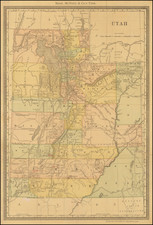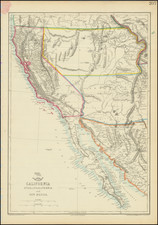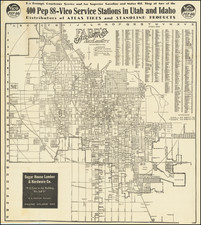Oil In the Area of Arches and Canyonlands National Parks
Interesting map of the oil region around Moab, Utah, printed on a broadsheet promoting the Embar Oil Company.
The map provides a visual image of a thriving oil region, with over a dozen wells being drilled. In fact, the region proved a spectacular failure at the time, although later efforts to find oil in the region did prove to be more successful.
The broadsheet is a stock prospectus for the Embar Oil Company's plans for oil wells from Thompson Springs (present day Arches) through Moab and on to Needles (Canyonlands). Also included is a letter to stockholders on Embar Oil Company letterhead and two blank proxy votes.
The prospectus notes:
The Embar Company as a partner with the Big Six Oil Company in the drilling of the Moab test well contributed in no small way in placing Utah on the map as probably one of the biggest future producers of high grade petroleum in the United States. It was largely upon the excellent showings of gas and oil in the Moab well and the presence of rich petroliferous shales that induced the drilling of Utah's big gusher.
Unlike many of these brochures, the Embar Oil Company seems to have been active in a number of states between 1917 and the late 1920s, including drilling activities in Wyoming, Utah and South Dakota. We found the following information relating to Embar and its partner, Big Six.
The Big Six Oil Company’s fortunes were linked to the prospects of finding oil near the city of Moab, Utah, where they began drilling in 1920. A contemporary publication reported the company’s progress and noted on February 7, 1921: “A continual round of difficulties have been encountered” and “a week’s fishing job drilling was resumed, only to be stopped the next day when the bit broke.”
The well was ultimately unsuccessful, despite having been drilled later to a total depth of 5,345 feet (with a No. 28 Star Rig) by the Embar Oil Company. Big Six was still in operation as late as October of 1928 when it lost a well – “Hole caved and bit lost” – at a depth of 1,710 feet, but disappears soon thereafter.
Early History of Moab and the Oil Industry
The first oil discovery in the Moab area occurred in the 1920s from the 300-million-year-old (Pennsylvanian aged) Paradox Formation. Drilling equipment and building materials were loaded on barges and floated down the Colorado River to where the first discovery was drilled on the axis of the Cane Creek anticline near the current site of the Moab potash mine.
The companies involved in this endeavor included the Utah-Southern Oil Company, the Midwest Enterprises Company, and John Howard's Utah Oil Refining Company. Together these three firms drilled a well that hit oil on December 8, 1925. At first the well gushed oil, gas, rock, sand, and gravel hundreds of feet into the air, but very quickly the 84-foot-high wooden derrick caught fire and burned. The Salt Lake Mining Review hailed the discovery as evidence that Utah had just joined the ranks of the "real petroleum-producing states." Such a sentiment was premature, however, because the well's promoters were unable to produce any oil from the venture despite their extending the well eventually to a depth of 5,000 feet.
Later, the equipment was floated farther down the river to Shafer dome, which only resulted in drilling a dry hole.
In 1957, drilling up on Big Flat, near present-day Dead Horse Point State Park, resulted in the discovery of oil in the Mississippian Redwall Limestone. This was the first discovery of oil from Mississippian-aged rocks in Utah. Ultimately, three oil wells and four dry holes were drilled in the Big Flat field, which was abandoned in 1971 after producing more than 83,000 barrels of oil (BO).
Since that time, there have been additional efforts to drill in the area, which continue into the 2020s.
Rarity
The broadsheet is apparently unrecorded.
OCLC locates no surviving documents referencing the Embar Oil Company.











![[ Ski Poster ] Alta](https://storage.googleapis.com/raremaps/img/small/102902.jpg)

![[ Jackson Hole and Environs ] Geological Map of Portions of Wyoming, Idaho and Utah](https://storage.googleapis.com/raremaps/img/small/97191.jpg)


